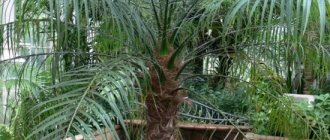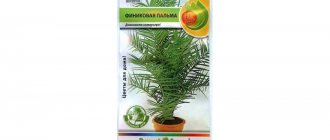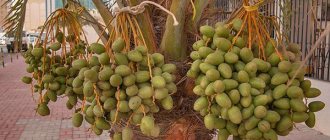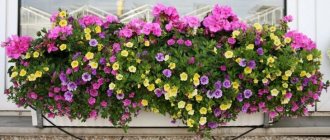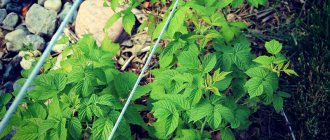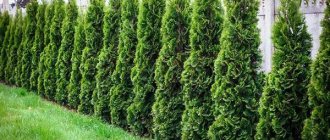Many people love dates. But many have tried them only as dried fruits, and not everyone has seen and tasted this exotic fruit fresh. A date tree can be grown in a garden plot or in an apartment. True, you won’t be able to expect fruit from it, but the plant is very decorative.
Types of date palm
The main varieties of palm trees include:
Canary
Homeland - Canary Islands. It can reach a height of 20 meters. The leaves are strong, pinnate, up to 5 meters long, the crown can include up to 200 leaves. The petiole is not too large with spines. The inflorescence is axillary, reaches 2 meters. This species is used in home greenhouses.
Canarian date palm
Palmate
Homeland: North Africa, Iran, Libya, Iraq. Height is 30 meters, powerful leaves are located at the top. The inflorescence may hang down due to the heavy weight of the fruit. The fruits are ovoid in shape, the pulp of which is protected by a hard shell. Dates of this type are very beneficial for the body.
Palmate date palm
Curved
Homeland - tropical and subtropical forests of Africa. It grows in several trunks at once, the height of which reaches 7 meters. The leaves are pinnate, belt-shaped, and can reach up to 6 meters in length. This type of palm tree is well cultivated in partial shade, with diffused light.
Bent date palm
Robelena
The humid Indian tropics are considered its homeland. The height of the tree is 2 meters, and there can be several trunks. The leaves are narrow and drooping, 50 to 60 cm long, located on a thin, short petiole. This type of palm tree can be successfully grown indoors.
Robelena
Rocky
Homeland - mountainous part of India. The trunk is straight, reaching 7 meters in height. The feathery, arched leaves can reach up to 2 meters in length. They grow densely, linearly, the inflorescence has a small petiole covered with thorns. It is successfully grown in greenhouses.
Stony date palm
Lesnaya
Grows in lowlands, along valleys and rivers, in the eastern regions of India. The plant has a single trunk with feathery leaves at the top, hanging down. Their length often reaches 4 meters. Petiole with dense spines, about a meter in diameter. The inflorescence is axillary, about 80 cm long.
Forest date
Ceylon
Homeland - Sri Lanka. The plant prefers a humid subtropical climate and is found in river valleys and lowlands. The leaves are pinnate, somewhat smaller in size than those of their species counterparts. The petiole is often small and covered with sharp spines. It is successfully grown in greenhouses.
Ceylon date palm
This applies to date palm species that grow in nature. These plants can also be found quite often in indoor and greenhouse conditions.
On our website you will also find information about types of palm trees such as dracaena and chamedorea. In addition, we have prepared for you materials on growing other “exotics”, such as bananas and avocados, as well as a whole series of articles on carnivorous plants. Read all about the Venus flytrap, Darlingtonia, Nepenthes, Sundew and Sarracenia.
Read more about what kind of care should be provided to a date palm tree indoors.
How to grow a palm tree from a date seed
The uniqueness of the date palm is that it can be grown from a seed.
For reproduction to occur, it is important to choose those dried fruits that have not been subjected to heat treatment. But such a palm tree will not bear fruit
Date pits, potting soil and sprouts
Preparing and germinating the seed
Separate the seeds from the dates, rinse thoroughly and soak in warm water for a day. For better germination, you can scald the seeds with boiling water. Next, the date seeds must be placed on a layer of wet cotton wool and covered with another layer.
Place the cotton wool in a container and place it in a very warm place for germination. It is necessary to constantly moisten the cotton wool and ensure that mold does not appear. Germination may take more than one month, so you should be patient.
Soil selection and planting
When a sprout appears on the seed, it can be planted in previously prepared soil. To prepare it, take: turf, peat, sawdust and humus in equal quantities. You can also use store-bought palm substrate.
Important! Place a layer of drainage on the bottom of the container. Deepen the bone a third into the ground
Place the container with the plantings in a warm place. Make sure that the soil in the container is slightly moist. A layer of sphagnum moss can be laid on top of the soil.
Sprout care
The first shoots will appear in 1-6 months. When they grow to 10-15 centimeters, they need to be transplanted into separate pots
It is important that the pots are high, as dates grow long roots. This is followed by an annual transplant into a larger pot.
During the growth period of young plants, pruning should not be carried out, since the growth point is located at the very top. The sprouts also need to be provided with full daylight and a stable air temperature.
Growing a date palm at home is the dream of many gardeners; it can easily be made a reality, you just need to put in a little effort and patience.
Top dressing
Flower shops sell special fertilizers for palm trees, but you can also buy preparations for ordinary plants with a high nitrogen content to form lush green mass. Fertilizing is done into the spilled soil according to the instructions.
Like any other indoor plant, it is better to under-fertilize a palm tree than to over-fertilize it. Compost, humus, and ash will also help the normal development of the tree.
Trimming
During the first years, pruning is strictly prohibited. When the tree is old enough, you can trim off the side shoots that are dry or of poor quality, but not the top, which is the growing point.
How to grow a tree from a seed at home
Many of the date palm species have their own domesticated “doubles”, which differ from their tall counterparts in their diminutiveness and unpretentiousness. The spectacular spreading indoor date palm is a wonderful decoration for a spacious home. If you like to tinker with indoor plants, it will not be difficult for you to grow it yourself at home from the seed left over from eating a ripe date. To do this, just place the seed in moist soil and maintain the moisture until the sprout appears.
True, you will have to wait a long time for the first sprout: sometimes it hatches only in the second month after placing the seed in the soil. So be patient - and then you can get a beauty 2 meters high, or even more. Light soil, a lot of light, rare but plentiful watering - these are the conditions that a home palm tree needs to feel good.
The only negative: date palms practically do not bear fruit at home, since for flowering, formation of ovaries and ripening of fruits they need a temperature above +35 C, which is impossible to achieve in an ordinary apartment - and what owner would sacrifice comfort for the sake of the flowering of a pet?
How to prepare for planting a date tree. To insure against possible failures, prepare several seeds for germination.
Clean the pit from any remaining pulp. Since it has a hard shell that prevents the sprout from breaking through, make cuts on it or rub it with sandpaper. Then it will be easier for the seed to germinate.
Wrap the bone in damp gauze or fabric that absorbs moisture well, place it in a bowl with water at the bottom and place it in a warm place, for example, on a radiator.
You need to regularly add water to the vessel so that moisture constantly flows to the bone. After two days, when the seed has swelled, it can be planted in the ground. And even more so if sprouts have appeared.
How to grow date palm from seed. The suitably prepared seed is placed in a peat pot. Peat must be mixed in equal proportions with sawdust and sand.
The swollen seed should be planted to a depth of one and a half times its size. Place the pot in a warm place (not lower than 25 degrees) and make sure that the soil is always moist.
After 1.5 months, the seed with the sprout that has appeared should be transplanted into a larger pot, 8-10 cm high. The soil should be prepared from a mixture of sand, turf, peat, humus and charcoal in a ratio of 4:2:2:2:1. The pot should be placed in a bright place, but not exposed to direct sunlight. The sprout should be watered regularly and also sprayed with water.
After another couple of months, when the sprouts become 12-15 cm high, they are again transplanted into a larger pot, now about 15 cm high. The composition of the soil remains the same. Place a layer of small pebbles at the bottom; they will ensure soil drainage.
How to care for a date palm. To ensure that all leaves receive sunlight evenly, rotate the palm pot regularly.
For watering, use well-settled water at room temperature. Don't forget to moisten the leaves with a spray bottle.
You should not make the soil too wet, but you should not allow it to dry out either. Periodically apply watering with special fertilizing, in spring and summer, during the period of active development, once a week, in autumn and winter - once a month.
The appearance of brown spots on the leaves indicates excessive soil moisture; watering should be limited.
When the leaves turn yellow, the reason is most likely due to insufficient watering.
If the leaves turn pale, the palm tree is getting too much sun and should be shaded.
Pest control is carried out in the usual way - the leaves are sprayed with garlic tincture, a solution of laundry soap, and other standard methods are used.
The palm grows at the top of the trunk, so it should not be trimmed.
In the first 5 years, it is recommended to replant the palm tree once a year, subsequently - every 3 years, after 15 years - every 5. The time for replanting comes when the roots completely fill the pot. When replanting, part of the roots forming the felt layer is cut off. At the same time, you need to increase the amount of turf and ensure good drainage.
Remember that palm trees have long roots, so choose a pot that is not necessarily wide, but high enough. A beautiful pot for a palm tree, stylized as an ancient Greek vessel or a barrel from an ancient ship, will become an original addition to the interior for its exotic owner.
And don't forget that a palm tree is a large plant. Is there enough space for it in your apartment? If you don’t think about this in advance, then, unfortunately, you will have to part with your favorite plant, donating it to a kindergarten or school.
Diseases and pests attacking dates
A well-cared for palm tree rarely gets sick. Here is a short list of diseases that dates are susceptible to and how to treat them.
| Cause | Signs on leaves | Treatment |
| Lack of nutrients | Yellowness. | Regular feeding. |
| Watering with hard water | Filtration of water for irrigation. | |
| Excessive watering | Brown, rotten smell. | Stop watering until the soil dries completely. |
| Lack of moisture | Darkening at the ends. | Correction of detention conditions, change of location. |
| Drafts | ||
| The air is too dry | ||
| Watering with cold water | ||
| Fungal diseases | Gray or pinkish spots. | Fungicides are antifungal drugs. It is not recommended to use more than once a week. |
In addition, the date palm can become the target of pest attack:
- The spider mite causes the leaves to turn yellow, dry out and curl, and entwine them with a thin web.
- Mealybugs suck the sap from the leaves, leaving a white, fluffy coating.
- Thrips contaminate and dehydrate, resulting in discolored spots.
- The scale insect attaches itself to the integument of the plant, drawing out the juice. It can be distinguished by its brown tubercles.
- Nematodes are worms that live inside leaves and cause them to thicken, deform and die. They are difficult to remove and spread quickly, so if they are detected, the plant should be destroyed along with the pot as quickly as possible.
Curved
Most insects can be removed using the following folk methods:
- Garlic infusion: 4 heads of garlic are dipped in 1 liter of water and kept for 5 days. The resulting extract is diluted with water and used to spray foliage.
- Tobacco infusion: add 40 grams of tobacco to 1 liter of water and leave for 2 days. Then add another liter of water and spray the plant.
- Soap-vodka solution: 15 g of liquid soap and a couple of tablespoons of vodka are diluted in 1 liter of water. Use once a week to wipe the leaves.
If the above methods are ineffective, it is necessary to treat the plant with agrochemicals, following the instructions.
It is recommended to first try the product on one leaf of the plant to determine the reaction.
Before processing, the soil must be covered with a film to protect it from foreign substances that could harm the composition of the soil.
Planting and caring for a date palm
The finger date, unlike other palm trees, has very good cold resistance. A tree accustomed to the extreme heat of the desert can survive long-term temperatures down to -14ºC.
This palm is practically indifferent to the quality of the soil. In nature, the tree successfully exists on bare sand. This is possible due to the fact that its root system is very powerful and developed. The rod goes ten meters or even more into the soil, feeding from groundwater. By the way, the ancient Arabs, focusing on date palms, laid out caravan routes. If these trees grow somewhere in the middle of the desert, there is definitely water nearby, you just need to find it. The crop also successfully takes root in heavy clay and poor rocky soils. Even the high level of salinity of the substrate does not frighten her.
Considering the extremely few “requirements” of the plant, date plantations are planted in open, well-lit and sun-warmed areas. Winds, even the strongest, are no hindrance to palm trees. The main thing is to make sure that there is groundwater in the selected area or to build an artificial irrigation system. And also give each plant sufficient area for nutrition, otherwise they will simply begin to “strangle” each other. Depending on the variety, 8–10 m are left between neighboring palm trees, and the row spacing is approximately the same.
Date plantations are planted where the plants receive enough heat and sunlight
Exclusively the root shoots of adult fruiting palms are used as planting material. Planting seedlings obtained from seeds is a kind of lottery, which cannot be afforded when growing fruits on an industrial scale. The varietal characteristics of such plants vary greatly. At home, on the contrary, cultivating date palms grown from seeds with one’s own hands is extremely popular. Anyway, they basically don’t bear fruit.
In Russia, date palms are grown mainly at home; they develop rather slowly
Video: date plantation
The Russian climate, as it was found out experimentally, is categorically not suitable for cultivating date palms on an industrial scale. They need the tropics, or at least subtropics. The Black Sea coast meets this requirement, but the culture there is not satisfied with high humidity. In the Sochi region, for example, date palms are planted exclusively as ornamental plants. They bloom, sometimes even fruits ripen, but their quality is extremely low.
At the same time, young plants under the age of 10 years can be irreversibly damaged even when the temperature drops to -8–10ºС. Therefore, for the winter, the bases of the stems are wrapped in several layers with any breathable covering material and covered with straw or reed mats. Be sure to cover the apical growth point as well. Sawdust, peat and sand are added to the planting hole, without fertilizers at all.
Palm tree care at home
The plant is characterized by slow growth and development. Caring for a palm tree is very simple. A person is required to follow standard rules so that the young tree pleases the eye and decorates the room.
Light and temperature conditions
Indoor date palm needs bright lighting. In summer, you can take it outside and leave it there until cold weather sets in. But it does not tolerate hot weather, so it is better to shade it during peak hours. Temperatures gradually decrease until winter. In summer it is 20-25 °C, in spring and autumn - 15-20 °C, and in winter only 9-11 °C. It is recommended to protect the palm tree from drafts. The tree has a sensitive root system, so pots should not be placed on cold window sills or stone floors.
Watering and irrigation
How often should you moisten the soil? In summer, make sure that the soil does not dry out or become covered with a rough crust. Overmoistening is also unacceptable. Watering is a procedure that completely depends on air temperature. The date palm is a tree with heat-tolerant and drought-resistant characteristics. But even it needs irrigation.
Feeding and fertilizer
How many times do you feed a palm tree? During growth, from spring to autumn, fertilizer is administered once every 2 weeks. In winter, at rest, you can get by with just 1 procedure per month. Dates respond positively to organic fertilizers. You can buy them or prepare them yourself.
Transfer
Each new palm pot should be 4 cm larger in diameter. During transplantation, you should not break off the top of the tree, as it may die. The palm tree does not tolerate “relocation” to a new container well. If the date is no more than 5 years old, replanting is carried out annually, older plants every 3 years. The bottom of the container is filled with a drainage layer. And they sprinkle earth on top, removing the outdated one. Transplantation is carried out if the roots become cramped in the pot. Roots that are too large and long can be seen through the drainage holes.
Development
There will be no need to observe the Date Palm as such for several years. It only produces single, narrow, sharp leaves. Spreading leaves appear only at 3-5 years. And all the beauty can be observed only at 5-7 years of growth.
If you want to quickly get an adult plant, you can use the vegetative propagation method by tearing off the basal shoot or side shoulder strap at the base of the trunk.
The importance of culture in the homeland
The culture of ancient eastern Arab countries is closely associated with the cultivation of this tree. Many researchers, not without reason, believe that it was the date palm that contributed to the formation of the geographical relief of these territories. Such changes made it possible to survive in local climatic conditions.
This tropical desert culture is considered the founder of oasis agriculture. Thanks to its height and spreading top, it provided sufficient shade in which other crops that could not tolerate the scorching sun were grown.
The situation was well understood by local farmers, so they practically idolized the palm tree; for them it was a “nurse,” “oasis queen,” “tree of prosperity.” As for the fruits of the date palm, they were called “bread of the desert.” A person's wealth was then measured in the number of camels and date palms.
And today, the fruits of these trees are actively used as food by the local population; there are many oriental recipes in which fruits are the main or additional ingredients.
Other beneficial functions for the body
Researchers say that dates can reduce the risk of developing abdominal cancer, as well as ease its consequences. These fruits act as a tonic for the body. They contain a lot of magnesium, a mineral known for its anti-inflammatory properties [13]. Thanks to it, the risk of arthritis, cardiac diseases, and Alzheimer's disease is reduced. Rich mineral composition and high levels of vitamin B6 make these fruits beneficial for brain function.
As the results of many experiments convince, dates are useful for pregnant women, since they have a beneficial effect on the development of the fetus and support the well-being of the expectant mother [14].
Growing at home
To grow a date palm you will have to be patient. It grows slowly and, unfortunately, will not bear fruit at home. To do this, its height must be at least 15 m. But this is not necessary. Even without fruits, an attractive plant with huge fans of leaves will decorate any interior. This will require a lot of space and light.
How to germinate a date seed?
Every plant starts with a seed. The date palm is no exception. There is no need to specifically look for its seeds - you can buy dates at any vegetable store. There is no point in planting date palm seeds that have not been germinated. Most likely, they simply will not sprout or the process will drag on for a very long time.
Watch this video on YouTube
So, let's germinate:
- select seeds from store-bought dates;
- we inspect them for damage, traces of mold or insects, and reject anything that is not standard;
- soak in clean water for a day to remove any remaining pulp, changing it several times; the pulp contains substances that inhibit seed germination;
- wash the seeds;
- we awaken the seed for 48 hours in a thermos with slightly warmed melt water with the addition of a few grains of humate;
- put it in a container with damp, loose material: vermicult, hydrogel, crushed and sterilized sphagnum moss, placing all this in a plastic bag;
- To germinate seeds, you need a temperature of about 35 degrees - a place near a heating radiator is ideal;
- germination takes from 2 to 3 months, and all this time you need to monitor the humidity of the substrate and remove condensation formed on the film.
As soon as sharp sprouts appeared, it was time to move the seeds into the ground.
Soil requirement
The best soil for both young palm trees and grown plants is palm substrate.
If it is not possible to purchase it, prepare the soil with the following composition:
- turf land;
- peat;
- sand.
All components are taken in equal parts. You can add a little steamed moss or hardwood sawdust for looseness. At this stage, a pot 10 or 12 cm high is enough for the plant. There should be drainage at the bottom of the pot.
There is no consensus among flower growers here. Most believe that the seed should be stuck vertically so that there is a 1 cm layer of soil above it. But there is an opinion that seeds placed in pots horizontally with the seam down and covered with a 2 cm thick layer of soil germinate better. In any case, start for the sake of one seed not worth the hassle. Their germination rate is not very good, so it is easier to plant several seeds in two pots in different ways and see which one is more effective. You will have to be patient while waiting for the shoots to emerge. Germination can take up to 5 months. All this time, a plastic bag should be placed on the pot, which should be removed for ventilation. The soil is sprayed with a spray bottle to maintain its moisture. The pots should be kept at a temperature of 20 to 30 degrees. They don't need light at this time.
What do palm trees look like?
The phoenix palm can bear fruit for one and a half to two hundred years. During this period, depending on the variety, the length of the trunk grows to an impressive height - from 15 to 40 meters. But there are also dwarf species, their height reaches 2–3 meters.
The trees have a straight column-like trunk, covered with crescent-shaped excisions - these are areas where the petioles of dead leaves are attached. The palm has an aerial part of an impressive size - the crown consists of fan-like leaves of a complex pinnate shape, 6 m long; in smaller trees they are “smaller” - from 2 m.
Over the course of a year, the plant develops about a dozen new “leaves” with spiky tips, the rigidity of which resembles plastic material. In the natural environment, young trees that have grown in large numbers resemble hedgehogs with prickly leaves; they create dense thickets that are impossible to pass through.
These trees are dioecious, meaning they can bear only male or female flowers. And fruit setting of date palms is impossible without cross-pollination. As a rule, it is provided by the wind.
Such “chaotic connections” between trees lead to the fact that fruits of various sizes, colors, shapes and tastes ripen on one plant.
It is important for breeders to avoid such an unpredictable result, therefore, when growing crops on an industrial scale, the selection of a pollinator variety is carried out under strict control, and the procedure is carried out only manually
Flowering trees look incredibly impressive; a palm flower consists of several inflorescences - up to a dozen, which fall in a magnificent cascade. They can reach a meter in length. The flowers have 3 golden-yellow petals - the male specimen opens completely, the female one retains a spherical shape.
Dates grow and ripen over a long period of up to 10 months. The palm tree blooms in late autumn - early winter; by about mid-spring the fruits become slightly yellowish; in May they are approximately the size of a large cherry. The fruits reach full ripeness only by the last summer month.
If you are wondering how dates grow on a palm tree, they are arranged like flowers - in the form of clusters. From a distance they can be mistaken for overgrown grape clusters. Such a bunch can weigh from 7 to 18 kg. Fruit-bearing trees are characterized by high productivity and from one plant you can get from 1 to 2.5 centners of fruit.
The first 5–10 kilogram harvest is harvested 5–6 years after the seedling is planted in the soil. The palm tree reaches maximum fertility by the age of 15.
Looking at the height of the trees and the impressive size of the bunches, a reasonable question arises - how are dates collected? As it turned out, this is an exclusively manual, rather dangerous job that requires a person to have remarkable strength, dexterity and dexterity.
The pickers have to go upstairs, armed with a special knife, cut off the brush and carefully lower them to the ground
Types of dates that can be grown from seeds
1500 varieties of date palms decorate different continents. But not everyone is capable of growing in artificially created conditions. Only dwarf forms of the palmate date can decorate offices and apartments. A date oasis can be created from the following varieties of palm trees:
- Robelena is distinguished by a dense, feathery crown and the ability to tolerate slight shading;
- Canary: the feathery trunk is crowned with hard and narrow leaves, the petioles are covered with thorns;
- The common or palmate variety is characterized by rapid growth and low decorative qualities: a bare trunk and a top of leaves;
- Curved is interesting because it forms several trunks and grows like a shrub;
- Ceylon has short leaves and spiny petioles;
- Stony received the title for its trunk, which quickly becomes bare;
- Forest is a giant date that is suitable for very large rooms or greenhouses.
True date palm (date palm)
The palmate palm is the same palm tree that produces delicious sweet dates that are sold in stores all year round. Each date contains an elongated pit with pointed tips. Seeds from store-bought dried fruits remain viable and are suitable for sowing.
The fruit of the palmate date is a famous sweet and tasty date.
The palmate date grows in the hot tropical deserts of Africa and Arabia. At the base of old trees, numerous root shoots often form, due to which plant regeneration occurs.
Real date palms grow in tropical deserts
Canarian date palm
The Canary date grows in the wild only in the Canary Islands. It is often grown as an ornamental plant in subtropics around the world, including in Russia along the Black Sea coast. This palm tree does not produce root shoots and reproduces only by seeds.
The Canarian date palm is grown as an ornamental plant in many countries
The fruits are not eaten due to their small size and fibrous pulp. Canary date seeds have an oval shape with rounded tips. You can pick up ripe fruits in December - January in the cities of the Black Sea coast, where these palm trees grow in abundance.
The fruits of the Canarian date are easily identified by the rounder seeds than those of the real date.
In my opinion, the Canarian date is more interesting for home cultivation: its plants have more graceful leaves and a fluffier crown, they look much more attractive than potted palmate date plants at a similar age.
Canarian date plants look very attractive
The palmate date is less decorative, but its seeds are easier to find
Beneficial features
The range of beneficial properties of dates is extremely wide. These fruits are useful for constipation, intestinal disorders, cardiac problems, anemia, sexual dysfunction, diarrhea, bloating, and some types of cancer. Dates are also a healthy food for people with underweight, as well as for people with vitamin deficiency. These tasty fruits contain healthy fats, sulfur, calcium, iron, phosphorus, potassium, manganese, magnesium, copper, which are necessary for the full functioning of the body, from the cellular level to the functionality of all systems. Nutritionists recommend eating at least 1 date daily to maintain mineral and vitamin balance.
The nutritional value of Phoenix dactylifera fruits has made it one of the best foods for muscle growth, as well as recovery from illness or injury. Some studies have shown that these sweet fruits can prevent abdominal cancer. In Muslim countries, it is customary to end fasting by eating dates. Nutritionists say this is a good practice because it helps prevent overeating after long-term dietary restrictions. On the other hand, dates allow you to quickly restore your supply of minerals and vitamins. Due to their high potassium concentration, they are an extremely important product for the nervous system [5].
What do we know about the palm tree?
The plant grows successfully in tropical climates. They say that the history of the date palm began a long time ago. There are suggestions that it was cultivated 8,000 years ago by tribes living in the territory of modern Iraq. Its fruits were consumed by the inhabitants of Mesopotamia. Some believe that the local population prepares a miraculous decoction from the sap obtained from the tree.
Palm bark is also used as a building material. Roofs are covered with its leaves; they are also used for weaving various products. In general, all parts of the plant are actively used.
The date palm looks quite unusual during flowering. It can contain more than two thousand flowers. They are collected in large inflorescences that hang in clusters from the palm tree. This is how dates grow on trees.
It is noteworthy that in hot desert areas this plant makes it possible to grow cereals and grapes. The palm tree creates darkness, which allows a person to engage in successful farming. How do dates grow in such conditions? The main “requirement” of a palm tree is a shallow groundwater table.
Interesting fact! The palm tree can be up to 100 years old. It grows only at night, since its day is entirely occupied by photosynthesis.
